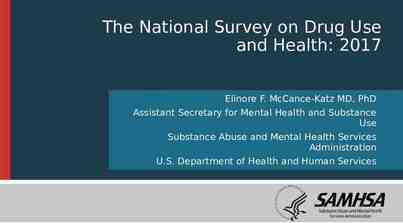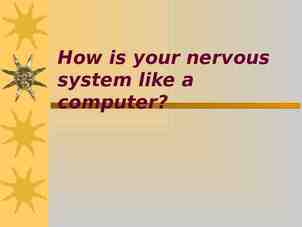Search Engine Optimization 101 March, 22nd 2018 Amy Manning – VP of
28 Slides6.07 MB
Search Engine Optimization 101 March, 22nd 2018 Amy Manning - VP of Digital Strategy
AGENDA 01 What is SEO 02 How does SEO work 03 How to succeed in SEO 04 Takeaways
01 WHAT IS SEO
WHAT IS SEO? Search engine optimization (SEO) – is the process of affecting the visibility of a website or a web page in a search engine's unpaid results - often referred to as "natural”, "organic”, or "earned" results
THE ANATOMY OF A SERP (Search Engine Results Page) Keyword / Search Query Paid Product Listings Paid Search Results Organic Search Results
SEARCH USERS PREFER ORGANIC LISTINGS 94% 6 % ORGANIC SEARCH CLICKS PAID SEARCH CLICKS Study of Search Queries (1.4 billion search) Source: Nielsen
ORGANIC IS THE MARKET-WIDE VOICE OF THE CUSTOMER Telling you what customers want in the moments that matter Buyers turn to organic at research stage Consumers use search engines for purchase decisions Smartphone users look for information, not brands
THE HIGHER YOUR WEB LISTING RANKS, THE MORE ORGANIC TRAFFIC IT CAN ACQUIRE 25% Organic Click-Through-Rate 20% 43% 15% of searchers click on the top 3 Organic SERP Rankings 10% 5% 0% 1 2 3 4 5 6 7 8 9 10 11 12 Search Rank Position 13 14 15 16 17 18 19 20
02 HOW DOES SEO WORK?
HOW DO SEARCH ENGINES WORK? Step 1: Step 2: Step 3: Crawl Links and Web Sites Index and Cache Web Pages Apply Ranking Algorithm Search engine bots crawl through the World Wide Web to find new websites based on the text on the website or links to websites As bots find pages on the web, they decide whether or not they want to include that web page within their index based on their own set of criteria Once a search engine has built up its index, it will rank the pages according to the relevancy to the search keyword and serve up the best results on SERP
GOOGLE ALGORITHM CHANGES MANY TIMES 100% SECURE SEARCH 2013 In an effort to protect internet users privacy Google removed traffic data insights on a keyword level PANDA AND PENGUIN UPDATES 2015 Poor quality content, duplicate content and bad backlink profiles penalized websites in the SERPs 2017 HUMMINGBIRD REMODEL Google algorithm includes “meaning technology” to better understand user intent; better content better rankings 2017 GOOGLE CAROUSEL AND RANK BRAIN SERP update that highlights websites in a new features top page carousel; this new layout impacts visibility and CTR. Rank Brain is a query refinement tool based on AI
SERP LAYOUT EVOLVES TO MEET SEARCH USERS’ NEEDS IN THOSE MICRO-MOMENTS 10 Blue Links Highly Contextual
03 HOW TO SUCCEED IN SEO
3 KEYS TO HIGHER SEARCH ENGINE RANKINGS Code Higher Search Engine Rankings Community Create a cleanly coded, search engine friendly website Be found on the web, promote your great content Content Produce great content
CODE - SEARCH ENGINES READ, THEY DON’T SEE “XYZ”, Just what I was looking for Best page for query “XYZ” Search Engine Bot
CODE - ON-PAGE OPTIMIZATION: TITLE TAGS Why is it important? Title is the most important on-page ranking factor and is the main text that describes an online document. What it looks like in the source code: Recommendation Use rich keyword phrases that best describe the web page Make them unique for each page and use a strong CTA (Call to Action) based on buyer intent Try to keep them around 55-65 characters long 1 2 3 4
CODE - ON-PAGE OPTIMIZATION: HEADER TAGS What is it? On-page HTML tags are located within the body copy that identify the most important text on the page. The H1 is the headline of the page. There are 6 header tags, ranging from H1 (the most important) to H6 (least important). What it looks like in the source code: Recommendation Use H1 only once per page Make sure the H1 is keyword rich and unique You can use H2 and H3 tags multiple times, but keep them unique from page to page Keep header tags in order 1 2 3 4
CODE - ON-PAGE OPTIMIZATION: META DESCRIPTION What is it? A description of what your web page is about. It will also show up as the page summary on the SERP. Why is it important? An engaging and descriptive meta description will attract more clicks when your pages shows up in search results. Think of it as a mini ad. Recommendation Include strong call-to-actions Make sure keyword is included early in the first line Make them unique for each page Try to keep them around 120-150 characters long 1 2 3 4
CONTENT - CREATING ENGAGING CONTENT 1. Prioritize profitable topics – Identify the 1-3 keywords or keyword phrases that relate to your topic 2. Tune content to your audience – Balance informative content for the human reader with keyword placement 3. Keep readers clicking – Ensure you have interlinking from your content to other related topics within your site 4. Keep published content optimized – Track content performance and optimize accordingly 1 2 3 4
CONTENT - KEY THINGS TO INCLUDE WHEN BUILDING NEW CONTENT Helpful web content brief template when creating each piece of content
CONTENT - KEYWORD RESEARCH FACTORS RELEVANCE Is your content and website addressing a need for this keyword? Would a customer expect to land on your site after searching for this keyword? SEARCH VOLUME USER INTENT High search volume indicates higher potential visits, but may also indicate higher ambiguity (for example “holidays” vs “luxury holidays in Maldives”) Is the customer looking to purchase, learn, or be entertained? Competition (Difficulty to rank higher) 1 2 3 4 Long tail terms offer lower search volume, but higher relevance; head terms offer higher potential visits, but lower relevance Head terms: High competition Long tail: Low competition
CONTENT - INTERNAL LINKS What is it? Internal links are links that go from one page on a domain to a different page on the same domain. They are commonly used in main navigation within a site. Internal links are often useful for several reasons: To allow users navigate a website To help establish information hierarchy for the given website To help spread link equity across a website To use as a ”soft conversion” CTA for top-of-the-funnel content a href "https://www.brightedge.com/products/s3/keyword-reporting" Keyword Reporting /a 1 2 3 4
CONTENT - ANCHOR TEXT What is it? Anchor text is the visible text on a page that can be clicked on and links to another page. In the example to the left, the login page has is an internal link to another section on the BrightEdge site. The anchor text that can be seen, “Content Performance”. What it looks like: The anchor text comes after the link in the source code. a href "https://www.brightedge.com/products/s3/keyword-reporting" Keyword Reporting /a a href "https://www.brightedge.com/products/s3/keyword-reporting" Keyword Reporting /a 1 2 3 4
COMMUNITY - PROMOTE YOUR GOOD CONTENT Work doesn’t stop when you hit “Publish.” Make sure to include promotional and cross-promotional efforts in your Content Strategy Use following channels to amplify your content: Link Building Social Media Public Relations Offline Media (TV, Radio, etc.) Paid Advertising Events posters or leave-behinds (QR code) Printed collateral (QR code) 1 2 3 4
COMMUNITY - WHAT IS LINK BUILDING? Link building is an ongoing iterative process where you build shareable, informative content and promote relevant content to the list of high-quality source domains through backlinks and social channels. Why is this important? Link building is an important area of SEO, as it influences a site’s domain authority. Higher domain authority correlates to higher ranking. Higher volumes of high quality backlinks leads to higher domain authority. Recommendation Focus on a natural, well-diversified, relevancy-based link building strategy to strengthen your profile. Tactics should primarily be focused around acquiring links from highquality domains - for example, a domain with a homepage that has a PageRank of 3 , or a domain with a Majestic Trust Flow of 20 . 1 2 3 4
COMMUNITY - WHAT ARE BACKLINKS? Without links, search engines might never find this page Backlinks point back to your site from an external site. They are considered to be “online currency”, getting a backlink is equivalent to receiving a vote of confidence 1 2 3 4
COMMUNITY - GOOD BACKLINKS VS. BAD BACKLINKS Your link is good if it is: Your link may be bad if the source: 1. EDITORIALLY PLACED: It is earned or volunteered freely from the linking source’s author/editor 2. CONTEXTUAL: It is contextually relevant to the page in which it is found, and naturally included therein 3. NATURAL: It uses relevant, descriptive, and (where appropriate) branded anchor text to describe the content of the link’s target 1. IS A LOW QUALITY DOMAIN: TrustFlow 20, PageRank 3 2. HOSTS LOW QUALITY CONTENT: Page or domain with frequent misspellings and bad grammar, duplicate, thin or machine-generated content 3. IS PART OF A LOW QUALITY NETWORK: Low-quality (content or equity) IP or subdomain group 1 2 3 4
TAKEAWAYS Focus on a manageable number of pages Ensure you’re building the right type of content for the SERP Link your content to relevant pages with keyword rich anchor text Promote pages on social media and with other teams

































